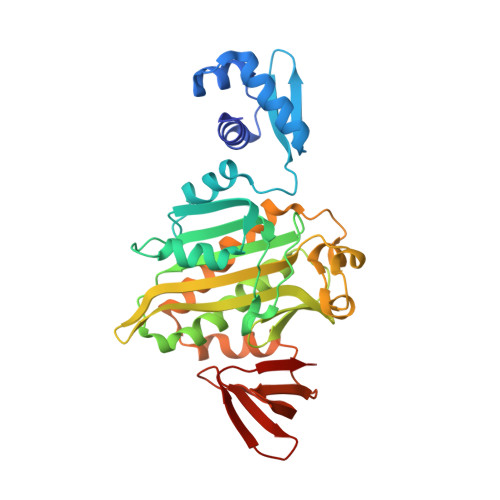Selective inhibition of biotin protein ligase from Staphylococcus aureus.
Soares da Costa, T.P., Tieu, W., Yap, M.Y., Pendini, N.R., Polyak, S.W., Sejer Pedersen, D., Morona, R., Turnidge, J.D., Wallace, J.C., Wilce, M.C., Booker, G.W., Abell, A.D.(2012) J Biological Chem 287: 17823-17832
- PubMed: 22437830
- DOI: https://doi.org/10.1074/jbc.M112.356576
- Primary Citation of Related Structures:
3V7C, 3V7R, 3V7S, 3V8J, 3V8K, 3V8L, 4DQ2 - PubMed Abstract:
There is a well documented need to replenish the antibiotic pipeline with new agents to combat the rise of drug resistant bacteria. One strategy to combat resistance is to discover new chemical classes immune to current resistance mechanisms that inhibit essential metabolic enzymes. Many of the obvious drug targets that have no homologous isozyme in the human host have now been investigated. Bacterial drug targets that have a closely related human homologue represent a new frontier in antibiotic discovery. However, to avoid potential toxicity to the host, these inhibitors must have very high selectivity for the bacterial enzyme over the human homolog. We have demonstrated that the essential enzyme biotin protein ligase (BPL) from the clinically important pathogen Staphylococcus aureus could be selectively inhibited. Linking biotin to adenosine via a 1,2,3 triazole yielded the first BPL inhibitor selective for S. aureus BPL over the human equivalent. The synthesis of new biotin 1,2,3-triazole analogues using click chemistry yielded our most potent structure (K(i) 90 nM) with a >1100-fold selectivity for the S. aureus BPL over the human homologue. X-ray crystallography confirmed the mechanism of inhibitor binding. Importantly, the inhibitor showed cytotoxicity against S. aureus but not cultured mammalian cells. The biotin 1,2,3-triazole provides a novel pharmacophore for future medicinal chemistry programs to develop this new antibiotic class.
- School of Molecular and Biomedical Science, University of Adelaide, Adelaide, South Australia 5005, Australia.
Organizational Affiliation:

















